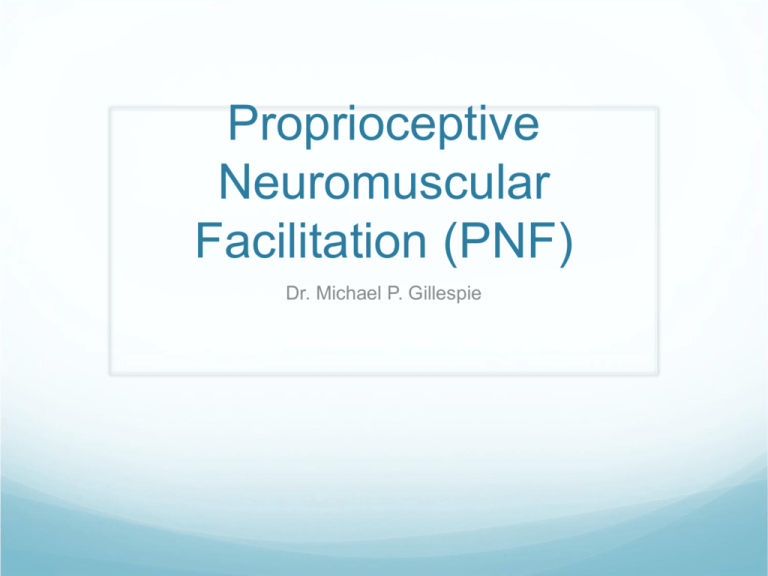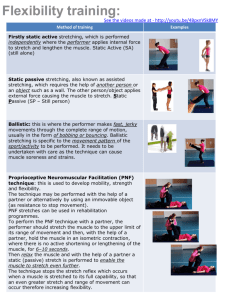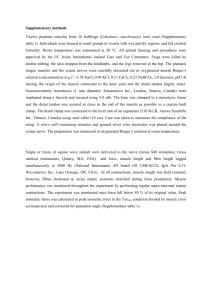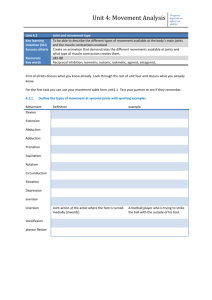Proprioceptive Neuromuscular Facilitation (PNF)
advertisement

Proprioceptive Neuromuscular Facilitation (PNF) Dr. Michael P. Gillespie When To Use PNF PNF stretches are most often used by athletes and individuals who have a range of motion that is less than normal. The two types of PNF to be discussed are as follows: Contract-relax technique Antagonistic contract-relax technique Contract-Relax Technique 1. Passively take a muscle through a range of motion that produces a mild (not painful) stretch tension. 2. Contract the muscle (with about the same force as a closed fist) for 4-5 seconds. 60-60 percent strength isometric contraction. Breathe. 3. Relax the muscle momentarily. 4. Perform a mild static stretch again for 5-15 seconds. 5. Repeat this process several times. Contract-Relax Technique Isotonic and Isometric Contractions Concentric isotonic contraction – a muscle shortens and pulls on another structure. Eccentric isotonic contraction – the length of a muscle increases during contraction. Isometric contraction – muscle tension is created; however, the muscle doesn’t shorten or lengthen. Post Isometric Relaxation 1. Bring the muscle to its maximum length without stretching, taking up the slack. There should be only minimal or no pain. 2. The patient is asked to resist with only minimal force (isometrically) and to breathe in for 10 seconds. 3. The patient is then told to ‘let go’ (relax) and exhale slowly. It is important for the doctor to wait and feel the relaxation. The doctor could wait 10 to 20 seconds or longer as relaxation is taking place. Due to pure relaxation there should be an increase in the range of motion. Post Isometric Relaxation 4. If the patient has difficulty relaxing, hold the isometric phase for 30 seconds before having the patient ‘let go’. 5. Usually three to five times is all that is necessary to obtain spontaneous stretch each session. 6. Along with breathing, have the patient look up (eyes only). This helps facilitate the inspiration, which facilitates the muscle. Have the patient look down during expiration to aid in relaxation. Post Isometric Relaxation This technique can be used with the force of gravity substituting for isometric resistance. Antagonist Contract-Relax Technique This technique uses the principle of contracting and relaxing opposing muscles (i.e. quadriceps and hamstring). You contract your quadriceps to relax the hamstrings and then stretch the hamstrings. This utilizes a principle of neurology known as reciprocal inhibition (A biomechanical Yin Yang). Coordination Within Muscle Groups Movements are typically the result of several skeletal muscles acting as a group. Most skeletal muscles are arranged in opposing (antagonistic) pairs at joints: Flexors – extensors, abductors – adductors, etc. One muscles is called the prime mover (agonist) which contracts to cause an action and the other muscle is called the antagonist which stretches and yields to the effects of the prime mover. Coordination Within Muscle Groups Synergists work with agonists to stabilize intermediate joints and assist the prime mover. Fixators stabilize the origin of the prime mover so that it can operate more efficiently. In limbs, a compartment is a group of skeletal muscles, with their associated blood vessels and nerves, that have a common function. i.e. In the upper limbs we have flexor compartments and extensor compartments. Example of Antagonist Contract-Relax Technique Start in a standing position and slowly bend forward from the hips (keeping the knees slightly flexed), until you reach a comfortable stretch. Note how far you are able to go. Return to a standing position, keeping your knees slightly flexed. Assume a flexed knee position. Hold for 15-20 seconds. This position contracts your quadriceps and relaxes your hamstrings. Stand up and go back into the first stretch. Hold for 5-15 seconds. You should be able to stretch further with the same effort. Antagonist Contract-Relax Technique






